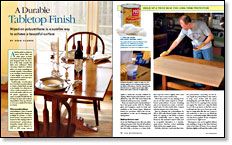A Durable Tabletop Finish
Wiped-on polyurethane is a surefire way to achieve a beautiful surface
Synopsis: Looking for the perfect finish that will make your kitchen table resist stains, heat, dents and scratches? The obvious choice is polyurethane. But, as Sean Clark explains, many woodworkers dont like the brush-marks and overall plastic appearance that often come with a thick polyurethane finish. His solution is a wipe-on method that builds layer upon layer of thinned polyurethane, for a finish that is all but foolproof.
From Fine Woodworking #171
A kitchen table is subject to more abuse than any other piece of furniture in the house: Heat, liquids, and dropped forks are just a few of the daily assaults this table must withstand. When choosing a finish for a kitchen table, you need something extremely durable. Polyurethane is an excellent choice because it rates highly as a water and solvent barrier, and it also has a high impact resistance.
Traditionally, woodworkers have brushed on polyurethane to obtain a finish thick enough to be durable. Too often the result is a surface marred by runs and brush marks, with an overall plastic appearance. My wipe-on method builds the finish layer by layer and is almost impossible to mess up. However, it is not a method for those in a hurry.
Polyurethanes, a class of varnish that is tough and fast-drying, are available in solvent- or waterbased forms; I recommend the former for this wiping method. Solvent-based polyurethane (hereafter simply called polyurethane) can be thinned by 20% to 30% using mineral spirits to make the viscosity suitable for wiping. Water-based polyurethane can be diluted by only 10% with water before the chemical makeup becomes unstable.
There are many brands of polyurethane. I have had great results with Pro Finisher gloss and semigloss, made by Parks and available at The Home Depot. Whatever brand you purchase, follow the recommendations on the can for thinning and drying times.
As in any finishing process, this one starts with good prep work. Smooth all surfaces with 220-grit sandpaper. Remove most of the dust with a vacuum or a clean cloth, then wipe the surfaces lightly with a tack cloth to remove any residual dust. This is the point to do any staining. Don’t use an oil stain under wiped-on solvent-based polyurethane because streaking may occur. Instead use a water- or alcohol-based stain. For this trestle table, I stayed with the natural color of the cherry.
For the full article, download the PDF below.
Fine Woodworking Recommended Products

Odie's Oil

Bumblechutes Bee’Nooba Wax

Diablo ‘SandNet’ Sanding Discs





















Log in or create an account to post a comment.
Sign up Log in